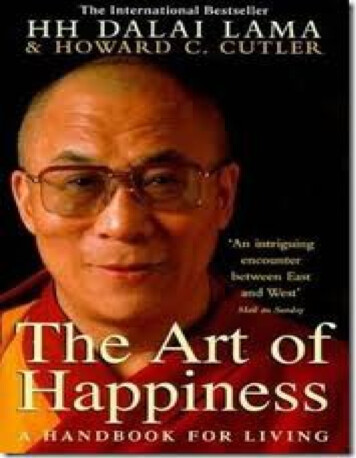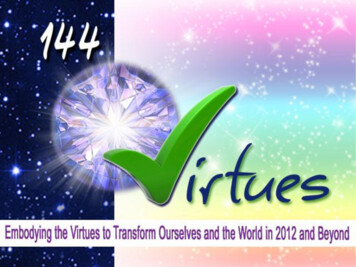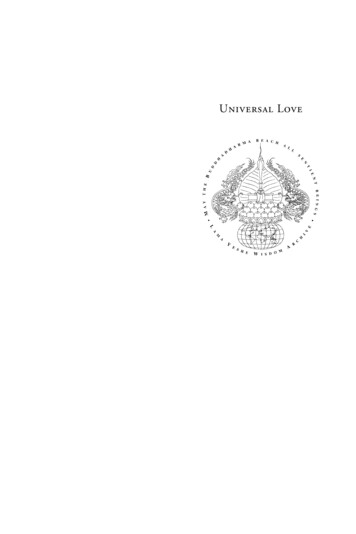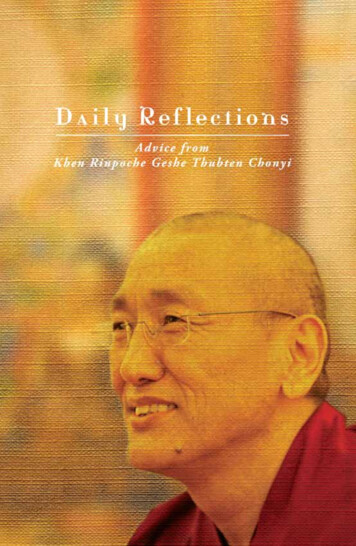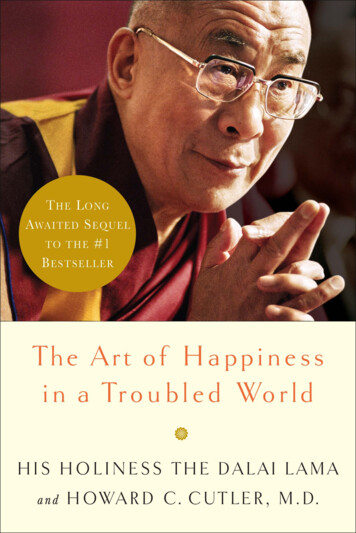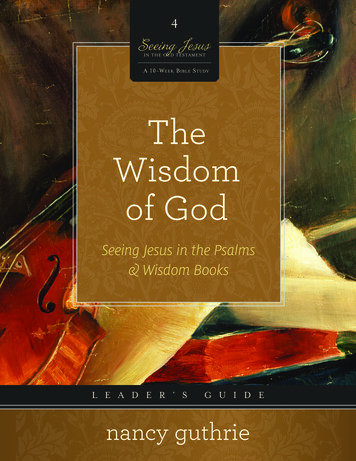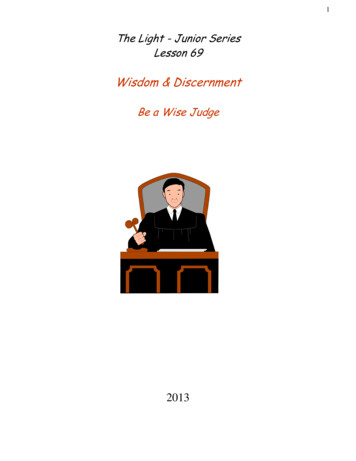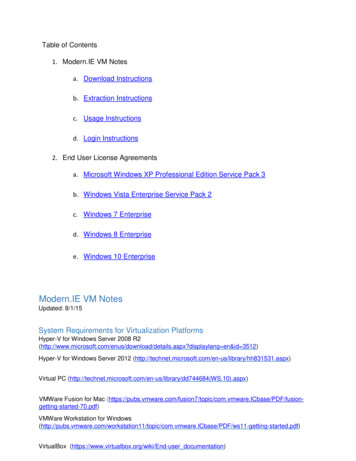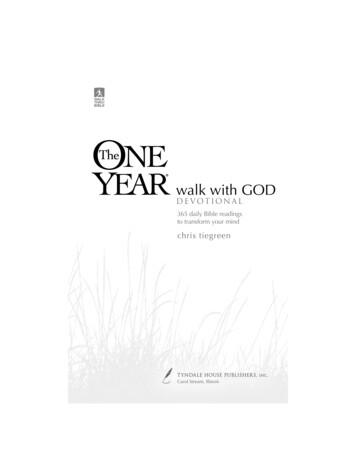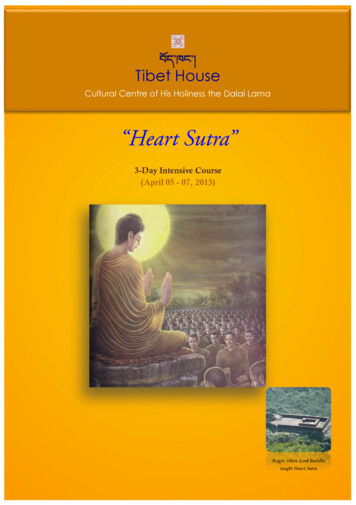
Transcription
4
5
6
7
8
9
10
11
12
The Heart of the Perfectionof Wisdom Sutra
Thus did hearat one time.Thus did I hear at one time.The Bhagavan was dwelling on Mass of Vultures Mountain in Rajagrihatogether with a great community of monks and a great communityof bodhisattvas. At that time, the Bhagavan was absorbed in theconcentration on the categories of phenomena called “ProfoundPerception.”Also, at that time, the bodhisattva mahasattva arya Avalokiteshvaralooked upon the very practice of the ‘Profound Perfection of Wisdom’ andbeheld those five aggregates also as empty of inherent nature.14
Then, through the power of Buddha, the venerable Shariputra said this tothe bodhisattva mahasattva arya Avalokiteshvara:“How should any son of the lineage train who wishes to practicethe activity of the Profound Perfection of Wisdom?”He said that and the bodhisattva mahasattva arya Avalokiteshvara saidthis to the venerable Sharadvatiputra.“Shariputra, any son of the lineage or daughter of the lineage whowishes to practice the activity of the Profound Perfection of Wisdomshould look upon it like this, correctly and repeatedly beholdingthose five aggregates also as empty of inherent nature.“Form is empty.Emptiness is form.Emptiness is not other than form;form is also not other than emptiness.In the same way, feeling, discrimination, compositional factors,15
and consciousness are empty.“Shariputra, likewise, all phenomena are emptiness; withoutcharacteristic; unproduced, unceased; stainless, not without stain;not deficient, not fulfilled.“Shariputra, therefore, in emptiness there is no form, no feeling, nodiscrimination, no compositional factors, no consciousness; no eye,no ear, no nose, no tongue, no body, no mind; no visual form, nosound, no odor, no taste, no object of touch, and no phenomenon.There is no eye element and so on up to and including no mindelement and no mental consciousness element.There is no ignorance, no extinction of ignorance, and so on up toand including no aging and death and no extinction of aging anddeath. Similarly, there is no suffering, origination, cessation, andpath; there is no exalted wisdom, no attainment, and alsono non-attainment.16
“Shariputra, therefore, because there is no attainment, bodhisattvasrely on and dwell in the perfection of wisdom, the mind withoutobscuration and without fear. Having completely passed beyonderror, they reach the end-point of nirvana. All the buddhas whodwell in the three times also manifestly, completely awaken tounsurpassable, perfect, complete enlightenment in reliance on theperfection of wisdom.“Therefore, the mantra of the perfection of wisdom, the mantra ofgreat knowledge, the unsurpassed mantra, the mantra equal to theunequaled, the mantra that thoroughly pacifies all suffering, shouldbe known as truth since it is not false.The mantra of the perfection of wisdom is declared:Tadyatha [OM] gate gate paragateparasamgate bodhi svaha17
“Shariputra, the bodhisattva mahasattva should train in theProfound Perfection of Wisdom like that.”Then the Bhagavan arose from that concentration and commended thebodhisattva mahasattva arya Avalokiteshvara saying:“Well said, well said, son of the lineage, it is like that!It is like that!One should practice the Profound Perfection of Wisdom justas you have indicated; even the tathagatas rejoice.”The Bhagavan having thus spoken, the venerable Sharadvatiputra, thebodhisattva mahasattva arya Avalokiteshvara, those surrounding in theirentirety along with the world of gods, humans, asuras, and gandharvaswere overjoyed and highly praised that spoken by the Bhagavan.(This completes the Aryabhagavati-prajnaparamita-hridaya-sutra)18
Pag pa kön chhog sum laPag pa kön chhog sum la chhag tshäl lo.chhag tshäl loDi kä dag gi thö pa dü chig naChom dän dä gyäl pöi khab ja gö phung pöi ri la ge long gi ge dün chhenpo dang / jang chhub sem päi ge dün chhen po dang thab chig tu zhug te/ Dei tshe chom dän dä zab mo nang wa zhe ja wäi chhö kyi nam drangkyi ting nge dzin la nyom par zhug so.Yang dei tshe jang chhub sem pa sem pa chhen po phag pa chän rä zigwang chhug she rab kyi pha röl tu chhin pa zab möi chö pa nyi la nam parta zhing / phung po nga po de dag la yang rang zhin gyi tong par nam parta o / de nä sang gyä kyi thü tshe dang dän pa sha ri bü / jang chhub sempa sem pa chhen po phag pa chän rä zig wang chhug la di kä che mä so /19
Rig kyi bu gang la la / she rab kyi pha rol tu chhin pa zab möi chöpa chä par dö pa de ji tar lab par ja / de kä che mä pa dangJang chhub sem pa sem pa chhen po phag pa chän rä zig wang chhug gitshe dang dän pa sha ra dva ti bu la di kä che mä so /Sha ri bu / rig kyi bu am rig kyi bu mo gang la la she rab kyi pha röltu chhin pa zab möi chö pa chä par dö pa de / di tar nam par ta warja te / phung po nga po de dag kyang rang zhin gyi tong par nampar yang dag par je su ta o.Zug tong pa o /tong pa nyi zug so.Zug lä tong pa nyi zhän ma yin /tong pa nyi lä kyang zug zhän ma yin no.20
De zhin du tshor wa dang / du she dang / du je dang / nam par shepa nam tong pa o.Sha ri bu / de tar chhö tham chä tong pa nyi de / tshän nyi me pama kye pa / ma gag pa / dri ma me pa / dri ma dang dräl wa me pa /dri wa me pa / gang wa me pa o.Sha ri bu / de ta wä na tong pa nyi la zug me / tshor wa me / du sheme / du je nam me / nam par she pa me mig me / na wa me /na me / che me / lü me / yi me zug me / dra me / dri me ro me /reg ja me / chhö me do.Mig gi kham me pa nä yi kyi kham me/ yi kyi nam par she päi khamkyi bar du yang me do.Ma rig pa me / ma rig pa zä pa me pa nä ga shi me / ga shi zä päibar du yang me do.21
De zhin du dug ngäl wa dang / kün jung wa dang / gog pa dang lamme ye she me / thob pa me / ma thob pa yang me do.Sha ri bu de ta wä na / jang chhub sem pa nam thob pa me päi chhirshe rab kyi pha röl tu chhin pa la ten ching nä te / sem la drib pa mepä trag pa me de.Chhin chi log lä shin tu dä nä / nya ngän lä dä päi thar chhin to.Dü sum du nam par zhug päi sang gyä tham chä kyang she rab kyipha röl tu chhin pa la ten nä / la na me pa yang dag par dzog päijang chhub tu ngön par dzög par sang gyä so.De ta wä na / she rab kyi pha röl tu chhin päi ngag / rig pa chhenpöi ngag la na me päi ngag /mi nyam pa dang nyam päi ngag dugngäl tham chä rab tu zhi war je päi ngag / mi dzün pä na den parshe par ja te.22
She rab kyi pha röl tu chhin päi ngag mä paTadyatha [OM] Gate Gate ParagateParasamgate Bodhi SvahaSha ri bu / jang chhub sem pa sem pa chhen pö de tar sherab kyi pha röl tu chhin pa zab mo la lab par ja o.De nä chom dän dä ting nge dzin de lä zheng te jang chhub sem pa sempa chhen po phag pa chän rä zig wang chhug la leg so zhe ja wa jin näLeg so leg so rig kyi bu de de zhin no.Rig kyi bu de de zhin te / ji tar khyö kyi tän pa de zhin du /she rab kyi pha röl tu chhin pa zab mo la chä par ja te /de zhin sheg pa nam kyang je su yi rang ngo.Chom dän dä kyi de kä che ka tsäl nä / tshe dang dän pa sha ra dva ti23
bu dang jang chhub sem pa sem pa chhen po phag pa chän rä zig wangchhug dang tham chä dang dän päi khor de dag dang lha dang / mi dang/ lha ma yin dang / dri zar chä päi jig ten yi rang te chom dän dä kyi sungpa la ngön par tö do.24COLOPHON:The Heart of the Perfection of Wisdom Sutra has been translated from the Tibetan, consulting theIndian and Tibetan commentaries and previous good translations, by Gelong Thubten Tsultrim(George Churinoff), the first day of Saka Dawa, 1999, at Tushita.
Il Sutra del Cuoredella vittoriosa Perfezione della Saggezza
Cosìuna voltaCosì una volta udii. udiiIl Bhagavan dimorava a Rajghir, sulla montagna Picco degli Avvoltoi,assieme a un vasto sangha di monaci e a un vasto sangha di bodhisattva.In quell’occasione il Bhagavan era assorbito nel samadhi sulle categoriedei fenomeni chiamato ‘Percezione Profonda’.Contemporaneamente, il bodhisattva mahasattva arya Avalokiteshvarastava applicandosi proprio nella pratica della ‘Profonda Perfezione dellaSaggezza’, e vide anche i cinque aggregati come vuoti di un’intrinsecanatura.26
Poi, tramite il potere del Buddha, il venerabile Shariputra così disse albodhisattva mahasattva arya Avalokiteshvara:“Come deve addestrarsi ogni figlio del lignaggio che desideriimpegnarsi nella pratica della Profonda Perfezione della Saggezza ?”Così egli parlò, e il bodhisattva mahasattva arya Avalokiteshvara risposeallora al venerabile figlio di Sharadvati:“Shariputra, ogni figlio o figlia del lignaggio che desideriimpegnarsi nella pratica della Profonda Perfezione della Saggezzadovrebbe applicarsi in essa nel seguente modo, apprendendocorrettamente e ripetutamente anche i cinque aggregati come vuotidi un’intrinseca natura.La forma è vuota,la vacuità è forma,la vacuità non è altro che formae la forma non è altro che vacuità.27
Allo stesso modo sono vuoti sensazioni, discriminazioni,fattori di composizione e coscienze.Similmente, Shariputra, tutti i fenomeni sono vacuità; sono prividi caratteristiche; non sono prodotti e non cessano; non sonocontaminati e non sono privi di contaminazioni; non diminuisconoe non crescono.Perciò, Shariputra, nella vacuità non c’è forma, né sensazione, nédiscriminazione, né fattore di composizione, né coscienza.Non c’è occhio, né orecchio, né naso, né lingua, né corpo, né mente.Non ci sono forme visive, né suoni, né odori, né sapori, né oggettitangibili, né fenomeni; e neppure il costituente dell’occhio e cosìvia, fino ad includere il costituente della mente e il costituente dellacoscienza mentale.Non c’è ignoranza, né estinzione dell’ignoranza, fino ad includereanche vecchiaia e morte, ed estinzione della vecchiaia e della morte.28
Similmente, non c’è sofferenza, origine, cessazione e sentiero;non c’è saggezza suprema, né ottenimenti, e neppure mancanza diottenimenti.Perciò, Shariputra, poiché non c’è ottenimento, i bodhisattva sibasano e dimorano nella perfezione della saggezza, le loro mentisenza più oscurazioni e senza paura. Essendo completamenteandati al di là di ogni errore, raggiungono il punto finale, il nirvana.E, affidandosi alla perfezione della saggezza, è evidente che tuttii buddha dimoranti nei tre tempi si sono anche completamenterisvegliati all’insorpassabile, perfetta e piena illuminazione.Perciò il mantra della perfezione della saggezza, il mantra dellagrande conoscenza, il mantra insorpassato, il mantra uguale a ciòche non ha eguali, il mantra che pacifica completamente tutte lesofferenze, dal momento che non è falso dovrebbe essere conosciutocome vero.29
Si proclama il mantra della perfezione della saggezza:Tayatha [OM] gate gate paragateparasamgate bodhi svahaShariputra, è in questo modo che il bodhisattva mahasattvadovrebbe addestrarsi nella Profonda Perfezione della Saggezza”.Quindi il Bhagavan riemerse da quel samadhi ed elogiò il bodhisattvamahasattva arya Avalokiteshvara dicendo:“Ben detto, ben detto, figlio del lignaggio, è proprio così!È proprio così!Si dovrebbe praticare la ‘Profonda Perfezione della Saggezza’proprio come tu hai mostrato; ne gioiscono perfino i tathagata!”Quando il Bhagavan ebbe così parlato, il venerabile figlio di Sharadvati,il bodhisattva mahasattva arya Avalokiteshvara, l’intera assemblea30
attorno a loro, assieme al mondo degli dei, uomini, semidei e gandharva,esultarono e porsero alte lodi alla parola del Bhagavan.(Termina qui l’Arya bhagavati prajñaparamita hridaya sutra.)31COLOPHON:Il Sutra del cuore della Perfezione della Saggezza. Tratto dal testo Preghiere Buddhiste Essenziali. Libro delle Preghiere FPMT,Edizione 2014.
Pag pa könchog sum laPag pa kön chog sum la chag tsäl lo.chag tsäl lodi ke dag ghi tö pe dü cig na / ciom den de ghiel pö kab ja gö pung pö rila / ghe long ghi ghe dün cen po dang / jang ciub sem pe ghe dün cen podang tab cig tu sciug te /dei tse ciom den de sab mo nang wa sce ja we ciö kyi nam drang kyi tingnghe dzin la gnom par sciug so /yang dei tse jang ciub sem pa sem pa cen po pag pa cen re sig wang ciugsce rab kyi pa röl tu cin pa sab mo ciö pa gni la nam par ta scingpung po nga po de dag la yang rang scin ghyi tong par nam par ta o /de ne sang ghie kyi tü tse dang den pa scia ri bü jang ciub sem pa sem pa32
cen po pag pa cen re sig wang ciug la di ke ce me sorig kyi bu gang la la / sce rab kyi pa rol tu cin pa sab mö ciöpa ce par dö pa de ji tar lab par ja / de ke ce me pa dangjang ciub sem pa sem pa cen po pag pa cen re sig wang ciug ghi tse dangden pa scia ra dva ti bu la di ke ce me soscia ri bu rig kyi bu am rig kyi bu mo gang la la sce rab kyi pa röl tucin pa sab mö ce pa ciö par dö pa dedi tar nam par ta war ja te / pung po nga po de dag la yangrang scin ghyi tong par nam par yang dag par je su ta osug tong pa o /tong pa gni sug sosug le kyang tong pa gni scen ma yin /tong pa gni le kyang sug scen ma yin node scin du tsor wa dang / du sce dang / du je nam dang /33
nam par sce pa nam tong pa oScia ri bu / de tar ciö tam ce tong pa gni de / tsen gni me pama kye pa / ma gag pa / dri ma me pa / dri ma dang drel wa / dri wame pa / gang wa me pa oscia ri bu / de ta we na / tong pa gni la sug me / tsor wa me / du sceme / du je nam me / nam par sce pa memig me / na wa me / na me / ce me / lü me / yi mesug me / dra me / dri me / ro me / reg ja me / ciö me domig ghi kam me pa ne yi kyi nam par sce pe kam kyi bar du yangme doma rig pa me / ma rig pa se pa me pa nega sci me / ga sci se pe bar du yang me dode scin du dug nghel wa dang / kün jung wa dang / gog pa dang /lam meye sce me / tob pa me / ma tob pa yang me do34
scia ri bu / de ta we na / jang ciub sem pa nam tob pa me pe cir / scerab kyi pa röl tu cin pa la ten cing ne te / sem la drib pa me cing tragpa me decin ci log le scin tu de ne / gna nghen le de pe tar cin todü sum du nam par sciug pe sang ghie tam ce kyang sce rab kyi paröl tu cin pa la ten ne / la na me pa yang dag par dzog pe jang ciubtu ngön par dzög par sang ghie sode ta we na / sce rab kyi pa röl tu cin pe ngag / rig pa cen pö ngagla na me pe ngag /mi gnam pa dang gnam pe ngagdug nghel tam ce rab tu sci war je pe nga g / mi dzün pe na / den parsce par ja tesce rab kyi pa röl tu cin pe ngag me paTadyatha [OM] gate gate paragateparasamgate bodhi svaha35
scia ri bu / jang ciub sem pa sem pa cen pö / de tar sce rab kyipa röl tu cin pa sab mo la lab par ja ode ne ciom den de ting nghe dzin de le sceng te / jang ciub sem pa sem pacen po pag pa cen re sig wang ciug la leg so sce ja wa jin neleg so leg so rig kyi bu de de scin no/ de de scin te / ji tar kyö kyi ten pa de scin du /rig kyi bu de de shin te / ji tar khyö kyi tän pa de shin du / she rabkyi pa röl tu chin pa sab mo la chä par ja te / de shin sheg pa namkyang je su yi rang ngoChom dän dä kyi de kä che ka tsäl nä / tse dang dän pa sha ra dva ti budangjang chub sem pa sem pa chen po pag pa chän rä sig wang chug dang tamchä dang dän päi khor de dag dang36
la dang / mi dang / la ma yin dang / dri sar chä päi jig ten yi rang te chomdän dä kyi sung pa la ngön par tö do chom dän dä kyi sung pa la ngönpar tö do(Termina qui l’Arya bhagavati prajñaparamita hridaya sutra.)37
grafica: Piero Sirianni08/2020 - Pomaia - Italy
The Heart of the Perfection of Wisdom Sutra has been translated from the Tibetan, consulting the Indian and Tibetan commentaries and previous good translations, by Gelong Thubten Tsultrim (George Churinoff), the first day of Saka Dawa,
